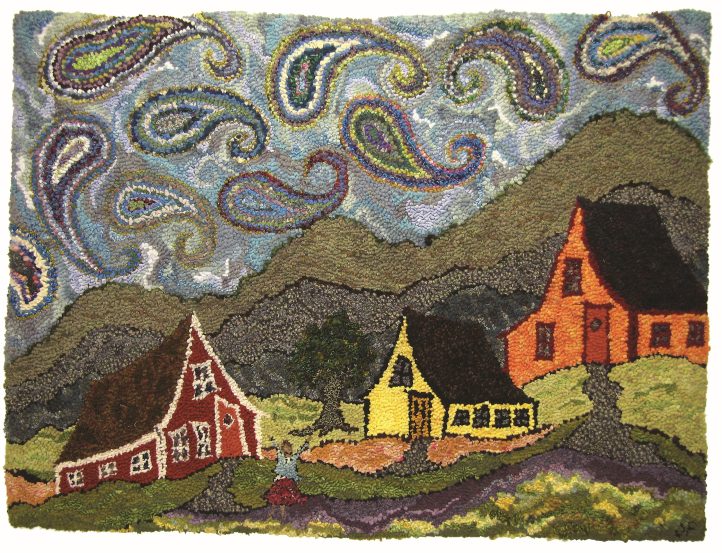
Deanne Fitzpatrick lives in Amherst, Nova Scotia, and has hooked plenty of skies in her rugs. She is the author of Hook Me a Story, a book about the history and method of rug hooking in Atlantic Canada. So Small under a Big Sky, 48″ x 58″, #6-, 8-, and hand-cut wool cloth and yarn on burlap. Designed and hooked by Deanne Fitzpatrick, Amherst, Nova Scotia, Canada, 2009. The sky is a playground, and I filled it with paisleys. Paisleys are fun to hook if you do not hold yourself to a pattern. Hook each one as its own little work of art.
TEXT AND PHOTOGRAPHY BY DEANNE FITZPATRICK
Nothing makes you realize how very small you are like looking up to the sky. No matter when you look—on a stormy day, a starry night, or a mauve summer evening—you see that the sky is not still. It is ever-changing and moody.
Hooking the sky and capturing those moods takes a lot of practice. It also takes a lot of attention. You have to notice what the skies look like, how they change depending on the weather, and how the time of day alters their appearance.
Take Time for Observation
Before you hook a sky, go outside and look up. You’ll see many different types of clouds: Cumulus clouds are big, heaping, fluffy clouds. Stratus clouds are thinly layered clouds. Cirrus clouds are like big curls of hair. Nimbus clouds are heavier-looking rain clouds. What kind of clouds best suit the day you want to depict? What time of day are you trying to capture? These are simple but important considerations.
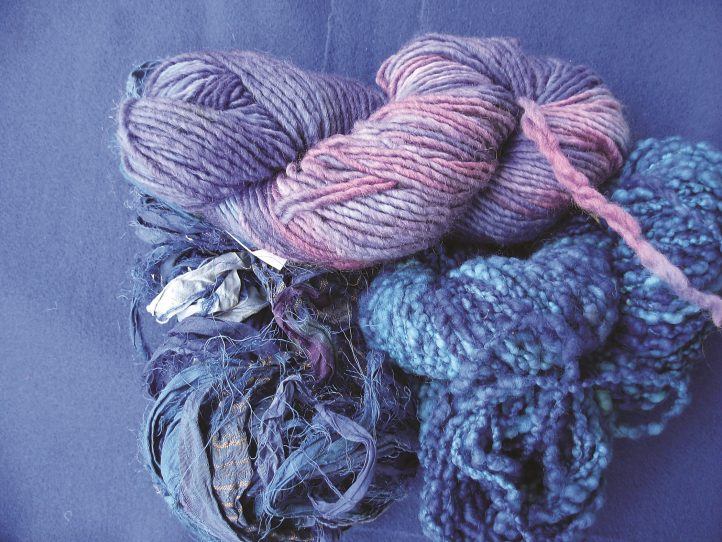
Gathering the right selection of yarns is important. Look for variegated blues in a variety of textures.
Notice where the light is coming from and where it hits. Not being aware of this natural phenomenon is a common mistake in pictorial rugs. For example, the landscape in a rug may be hooked in bright and sunny colors, but the sky is gray. This inconsistency might confuse the viewer: where is the light coming from? The type of sky has to match the type of light that shows on the ground.
The next time you see a beautiful sunset, notice the interaction among the colors in the sky. Sometimes rug hookers hook sunsets in lines straight across their backing, but all the viewer ends up seeing is the direction of the hooking rather than the sky itself. When you hook in straight lines, it is hard to blend the shades of the wool together. Instead, one color ends abruptly and another begins. Rather than a nice, blended sunset, the result is a choppy sky.
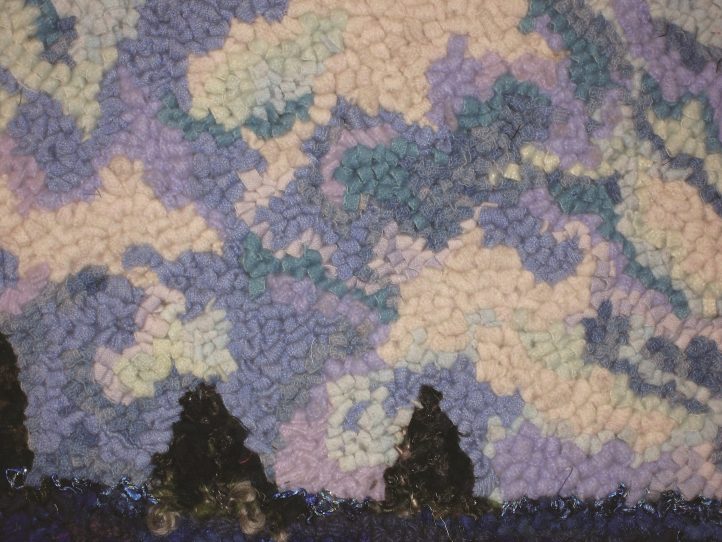
You can see many shades very close together, highlighted with fleece for clouds, and a darker mauve for depth.
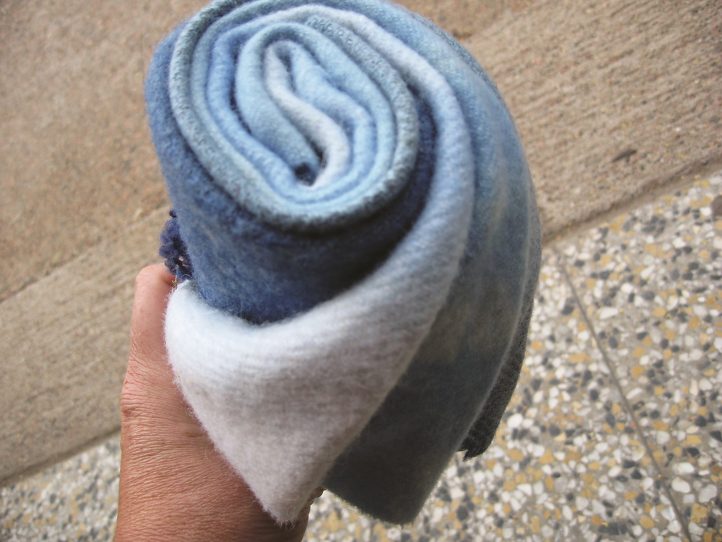
I use many shades of sky blue for a sky. Often they are so close together that the variation is only slight. I like how they hook up together.
A Realistic Approach to Hooking Skies
I take many different approaches to hooking skies, depending on the feeling I want to convey. Sometimes I want to convey the sky exactly the way I see it. When I hook it in a realistic way, I usually take fleece (natural sheep’s wool) and hook in the clouds first. I hook the clouds in all directions: up, down, and across.
You can hook three loops over, turn down two loops, then go back four loops, then back two. Any pattern can work. I then add the same color again, going back and forth, up and down, and filling in. Think of it like baking biscuits: you can change the ingredients a bit and you still get nice fluffy biscuits.
When I don’t want really fluffy clouds, I use a white wool cloth or a sweater. Strips cut from wool sweaters make great clouds because they curl as you hook them. They are full without being overpowering, and they add interest because the viewer cannot immediately identify what material the rug hooker used. I follow the same method of hooking as I did with the fleece, but I change materials and colors a bit. A cloud becomes more interesting because the various shades and textures appear as a play on light. Try colors like pale yellows, creamy mauves, pale grays, and a variety of whites and creams. Always remember: your color choices depict mood, time of day, and light.
Once the clouds are hooked, I add the colors of the sky. For a bright sunny day, I might choose four or five shades of pale blue. Sometimes I’ll throw in a bright mauve. I hook the sky the same way I hook the clouds, but in larger areas. I often think of the sky as a big series of clouds all mashed together, but some are blue. This approach is relaxing because you are really hooking one step—or one cloud—at a time.
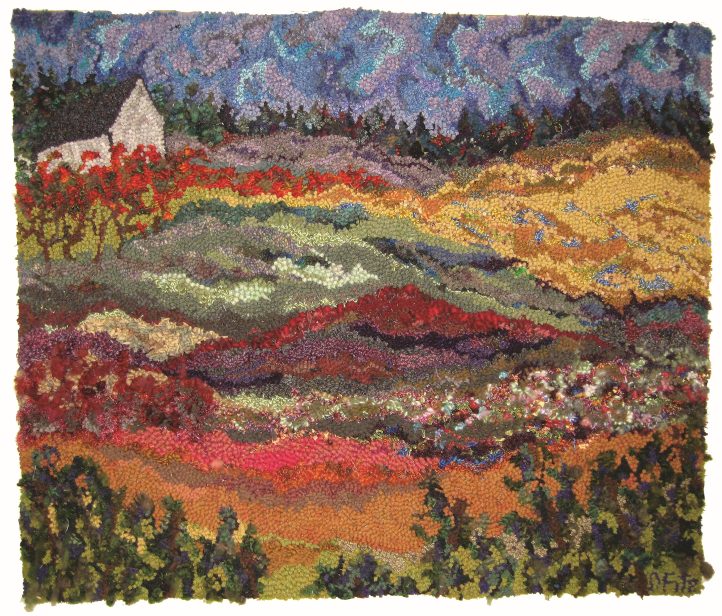
Vines in the Field, 60″ x 52″, #6-, 8-, and hand-cut wool cloth and yarn on burlap. Designed and hooked by Deanne Fitzpatrick, Amherst, Nova Scotia, Canada, 2004. There is an upward motion of hooking in this sky. I hooked in small patches toward the outside edge of the rug, as if the sky was going off the rug. To me, this implies an expansiveness to the sky that is beyond what is shown.
The “big blue sky” is one of my favorite skies to hook. For that sky I choose three to ten colors of pale blue that are fairly close together. (Almost any number of shades is fine, if you keep the colors close together.) Some of the shades can be different textures. For example, a bouclé wool cloth, yarn, and fleece work well together. Hook these colors and textures in big fluffy areas, similar to cumulus clouds. I never leave straight hard edges. I round them off instead.
Because I hook with a loose, big stitch, using #6- and 8-cut wool, I can blend the colors together as I hook. When I am introducing a new color up against another, I hook tightly because I want one color to blend into the other. It is the old idea of fingering used among flower shaders, except instead of fingers of wool loops, these are wobbly lines of wool loops.
I choose colors that are very close together. They can be several shades of any color, depending on the type of sky I want to create. The beauty of having the colors close together is that the mixing becomes very easy and the shading is incredibly subtle. You can only really see the beauty of the shading when the rug is done and you step away from it and see it as a whole. Trust me on this: it works with grays, mauves, deep blues, and a variety of other colors. I have hooked this type of sky over 100 times. Probably even more than that, because I love these strong skies.
A Lighter Approach
Other times, in other rugs, the sky is an area that should be whimsical. Start to think of the sky not as part of the landscape, but as a place to be creative and expressive. This approach has led me to a lot of delightful designs. I hook the sky as if it were a playground. I have filled huge skies with paisleys, diamonds, or circles, just for the pleasure of it.
A whimsical sky gives the rug a more contemporary feel. The viewer is attracted to the sky by the patterns. The pattern lures his eye upward.
For me, pattern in the sky is a play on the traditional pictorial, making rugs more fun. It takes something that is so strong in rug hooking—the use of repetitive design—and pushes the edges of the mat a little further along. I discovered this one day when faced with a big sky to hook. I had no idea if it would work, but I thought it was worth a try. It worked so well that I have continued to play with the idea for the last two years.
As you start your next sky, be fearless. Remember, if it doesn’t work well, you can always start again. Start thinking of your rug as a series of spaces that need to be filled, and you never know where your imagination might take you.
IF YOU WANT TO HOOK THE SKY
- Think about the weather before you start the sky. The weather affects the color of the sky.
- Avoid hooking straight across. The sky is full of movement, so use movement in your hooking to get that feeling. Draw swirling lines on your rug to guide you.
- Pick blues, but don’t underestimate the power of other colors to create mood, such as pale greens, mauves, pale yellows, and grays.
- Natural sheep’s wool fleece is perfect for clouds, but do not hook it in perfect ovals; try hooking it in odd, irregular shapes.
- Remember to change the direction of your hooking. Skies call for motion in your hooking. This technique is hard to get used to, but the result is great skies.
- Be liberal with creams and whites. Some days the sky has more cloud cover than blue.
SKY TIP
Skies are some of the more interesting areas of the mat to hook, but they take practice. Why not create a set of samplers for yourself? Take four small pictorials—it can even be the same pattern—and hook each one with a different style of sky. Try a rug that is 10″ by 14″, perhaps with a single small house in the corner, and hook the rest in sky. We learn by doing, and with each sky we hook, we are more prepared for the next one.
STORMY SKY

Winter Sky, 20″ x 36″, #6-, 8-, and hand-cut wool cloth and yarn on burlap. Designed and hooked by Deanne Fitzpatrick, Amherst, Nova Scotia, Canada, 2005. The drama in this rug is all in the sky. You can really use the sky as an area to play with and fill with intensity. I drew these big swirls, hooked them first, and then filled in the background. It suggests a stormy sky.
- A stormy sky is not just a gray sky. It is made up of shades of grays and blues and creams.
- A stormy sky has lots of motion and movement. It is an unsettled sky that has a lot of drama.
- Use dark colors to emphasize the heaviness of the impending storm. Deep shades of gray, gray blue, and gray green really emphasize that heavy feeling.
- Clouds in the stormy sky could be pale yellow or lightest gray or cream to accentuate that unsettled feeling.
NIGHT SKY

The Words Between Us, 16″ x 24″, #6-, 8-, and hand-cut wool cloth and yarn on burlap. Designed and hooked by Deanne Fitzpatrick, Amherst, Nova Scotia, Canada, 2008. Here the sky is used as an expressive space. The swirls come right out of the mouths as if the light in the sky is the words between them. Look at the navy and see how many colors actually highlight it. Do not limit yourself to a small palette when hooking night skies.
- Use a navy skirt as the base of the night sky and add two or three other similar, but slightly brighter, shades of navy with it. Throw in some black, dark green, or purple for highlights.
- Hook tiny circles of yellow or white, two or three loops each, for stars.
- Throw in some multicolored mohair yarns with red, blue, pink, etc.
- Hook the sky from the ground toward the top of the sky in big jagged thick lines, always starting and finishing in different places.
PAISLEYS IN THE SKY
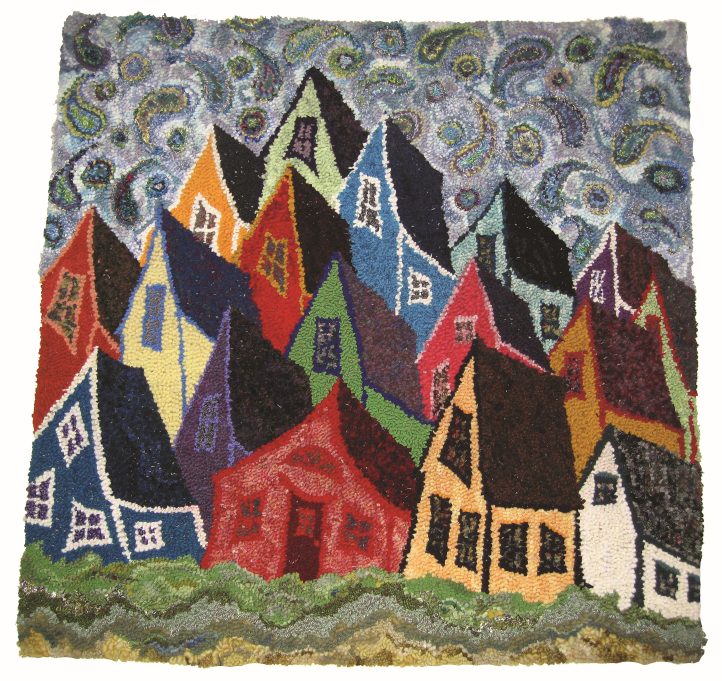
Peaks to the Sky, 58″ x 64″, #6-, 8-, and hand-cut wool cloth and yarn on burlap. Designed and hooked by Deanne Fitzpatrick, Amherst, Nova Scotia, Canada, 2005. Circles and paisleys meet in this sky. You will see that each circle or paisley is unique and contains many different colors—some of the colors you would not expect to find, like lime green. Surprise and added interest make this sky.
- First draw the shape of the paisley, circles, diamonds, or other unique shapes on the area you want to be the sky.
- Truncate some of the shapes. Allow half of a circle to come out to the edge of your rug. This design technique adds interest.
- Mix shapes. I like to mix circles and paisleys together. Use shapes that complement each other. But be careful: too many different shapes get too busy and distract from the mat.
- Shapes add a magical quality to the sky. They take the rug from impressionism or realism to playfulness.
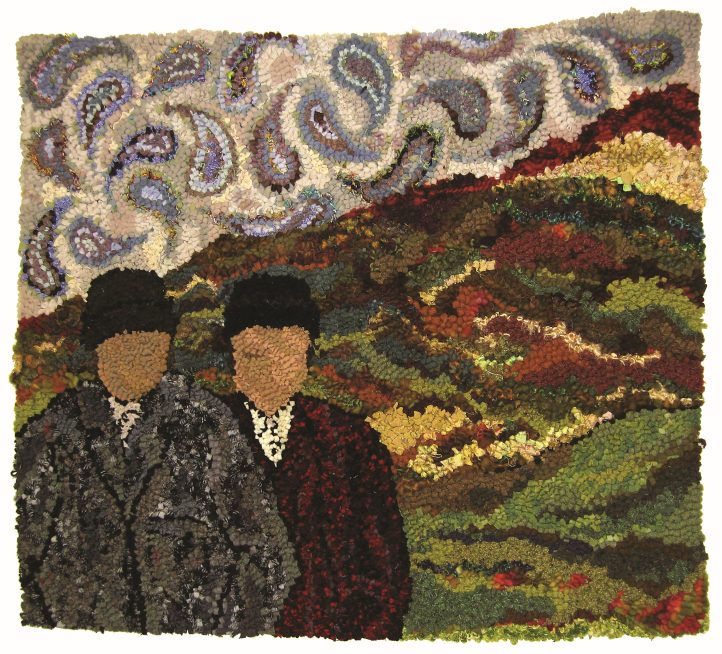
Out on the Barrens, 44″ x 54″, #6-, 8-, and hand-cut wool cloth and yarn on burlap. Designed and hooked by Deanne Fitzpatrick, Amherst, Nova Scotia, Canada, 2009. The light gray backgrounds on these paisleys soften them and make them less playful and more ponderous. Keep the background behind paisleys fairly solid. Some variegation is fine, but you do not want it to compete with the paisleys. This particular paisley sky suggests an impending storm.
HOOKING THE EVENING SKY
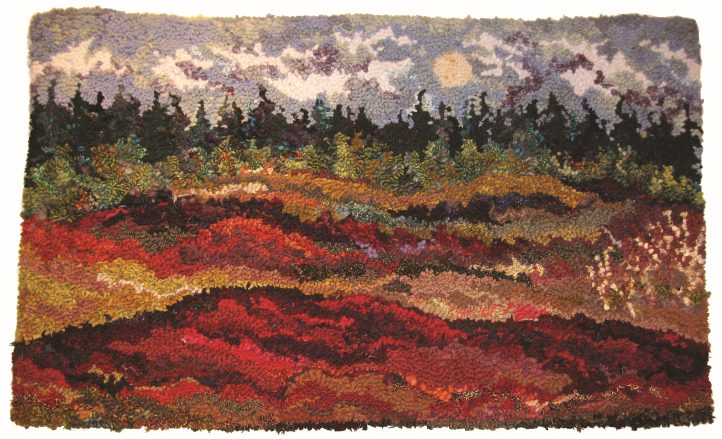
Moon over County Road, 20″ x 35″, #6-, 8-, and hand-cut wool cloth and yarn on burlap. Designed and hooked by Deanne Fitzpatrick, Amherst, Nova Scotia, Canada, 2005. I love thin cirrus clouds and added bits of mauve against a background blue gray sky. The moon works well in a bit of mixed creams. I find a loosely woven cream sweater hooks up well for the moon.
- Color is the key to communicating the time of day. For evening sky, blue with a pink cast or mauve will take you there. Gather some mid-blues and a complementary mauve and hook them together. I use three swatches of blues to one swatch of mauve.
- Think of evening skies as long stretches of color, not hooked across in straight lines, but in longer, narrow swaths.
